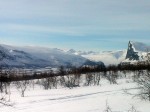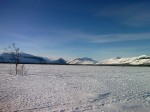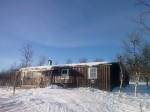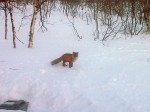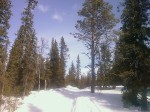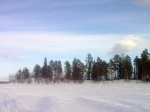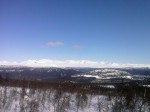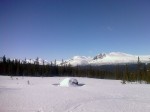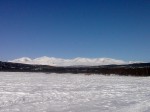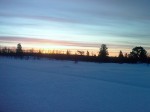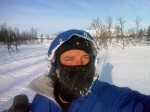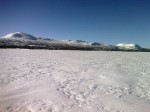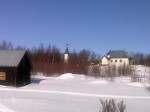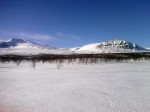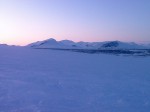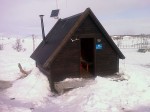Day 85. Sitojaure to Saltoluokta
Thursday, March 26th, 2009Distance 20km | Time 4hrs | Ascent 210m | Descent 460m
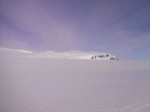 I managed to get to bed early and slept well. I was awake at 0600 and up at 0700. The two happy, chatty Germans were already breakfasting and the admirable Austrian 70 year olds were soon to join. It had been a coldish night at minus 23 but it was now sunny again as I had almost started to take for granted.
I managed to get to bed early and slept well. I was awake at 0600 and up at 0700. The two happy, chatty Germans were already breakfasting and the admirable Austrian 70 year olds were soon to join. It had been a coldish night at minus 23 but it was now sunny again as I had almost started to take for granted.
After some chatting I was packed and ready to go at 0900. We pretty much all left at the same time after a final banter with the happy warden. It was now just minus 18 and rising fast.
The route followed the barely used scooter track north up the gentle valley My skis gripped too firmly to the cold snow as I skied up through the birch trees. There had been a lot of snow here and the hill on either side of the valley were plastered in a thick covering of snow.
The bruising in my bum after the heavy fall 2 days ago was not such a hindrance any more but I could still not put much power through that leg without feeling some pain.
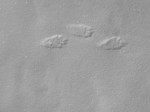 I saw some wolverine tracks crossing the route here. They only weigh about 15 kg but have large paws. The paws are up to 10 cm across. These prints were fresh. With their large paws they can travel well across soft snow and sometimes catch their main prey, which is reindeer.
I saw some wolverine tracks crossing the route here. They only weigh about 15 kg but have large paws. The paws are up to 10 cm across. These prints were fresh. With their large paws they can travel well across soft snow and sometimes catch their main prey, which is reindeer.
I continued up the valley for a good two hours until it flattened off completely. Not that it was ever steep. Here there was an emergency shelter which was about half way to Saltoluokta. I could see from the 2 sledges outside that the young Germans were lunching here. I did not feel like a break though so continued.
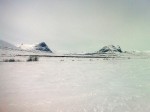 The very gentle valley I was following now veered to the north west towards Pietsaure lake. This lake was sandwiched between the craggy mountains of Rasek and Gierkav. I was not going down onto this lake but over a gentle spur to the north. I climb up the very shallow incline to the top of the spur seperating this valley from the larger, deeper valley to the north where Langas lake was.
The very gentle valley I was following now veered to the north west towards Pietsaure lake. This lake was sandwiched between the craggy mountains of Rasek and Gierkav. I was not going down onto this lake but over a gentle spur to the north. I climb up the very shallow incline to the top of the spur seperating this valley from the larger, deeper valley to the north where Langas lake was.
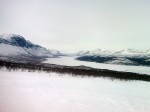 From this spur I got a great view up the lake to the north west end. Here there was once a great waterfall called Stora Sjofallet. It was so spectacular and large the whole area was made into a national park in 1909. It was sometimes called Europes Niagara which was a bit of an exaggeration but not much as there was a huge volume of water which descended these falls.
From this spur I got a great view up the lake to the north west end. Here there was once a great waterfall called Stora Sjofallet. It was so spectacular and large the whole area was made into a national park in 1909. It was sometimes called Europes Niagara which was a bit of an exaggeration but not much as there was a huge volume of water which descended these falls.
However as soon as this natural wonder was preserved by law as a national park the government decided to overrule its decision a few years later and remove the vicinity of the waterfall from the park so it could be exploited for hydroelectricity. Today the falls are gone, the entire volume of water by passing them in pipes.
This means the ice on Langas lake is dubious. Not only is it dammed so the water level fluctuates due to the out-take, but two inflows at Vietas are subject to hydroelectric regulation. As a consequence the hydroelectric company is forced to build up an ice route between Saltoluokta and the north shore. They do this by spreading water on the ice at the beginning of the season. If they don’t then by law they have to ferry tourists across the lake by helicopter. Luckily for me the ice route was firm as I could not take a helicopter and the alternative was a long detour.
The descent from the ridge down to Saltoluokta lodge was wonderful. It was becoming a familiar pattern. First the descent down the open hillside to the birch forest. Then through this to the comfort of the pine forest where th lodge lay.
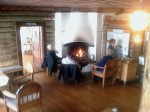 It was built in 1916 just before this beautiful valley was flooded. It retains much of its charm, with old log walls and rustic furniture. It seems slightly different from the STF cabins as most of the visitors come here and stay put doing day tours. It has built up a reputation for fine food and it looks as if most of the other guests come to enjoy the old comfortable buildings and fine food as much as the leisurely day skis.
It was built in 1916 just before this beautiful valley was flooded. It retains much of its charm, with old log walls and rustic furniture. It seems slightly different from the STF cabins as most of the visitors come here and stay put doing day tours. It has built up a reputation for fine food and it looks as if most of the other guests come to enjoy the old comfortable buildings and fine food as much as the leisurely day skis.
I took a shared room knowing no one else here would probably share a room and then sat in front of the open fire and wrote the blog. It felt great to have it finished before supper which promised to be sumptious. Tomorrow was an early start and long day across various frozen lakes to Teusajaure cabin some 40 km to the north west.
It was an easy day. Almost a rest day. The pain in my bum was easing but I had a nagging pain in my wrist from the ski stick. The weather was easy although the fine spell seemed to be coming to an end. I would enjoy a bit of comfort and some polite, calm, middle aged and middle class chat this evening before crossing to the more frank, rugged northern quarter of the Kungsleden tomorrow. This northern quarter went up through the Kebnekaise area and was quite mountainous.
